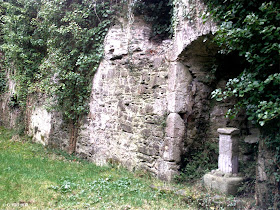A guide to the best and sometimes off the beaten track historical ruins around Ireland and how to get there.
Saturday, 12 October 2013
Old Coghlanstown West Church Co Kildare
Above Image: The roadside gate
Above Image: Entrance doorway
Above 2 Images The font pedestal
Above 2 Images: The hidden stairwell
Above Image: The cross base
Above 2 Images: The Cross at Coghlanstown East
While the exact date of construction of this church is vague there is positioned within it a shaft of a possible font with an inscription "Eustace Lord Portleter" and dated 1462AD.
The church, a local parish building stands now in ruins and has done so for many years. It was listed on an 1897 map as being in a ruinous state at that time. All four walls still stand although they are very much ivy covered. There is also in existence here a holy well dedicated to St James adjacent to the south facing wall which would lead one to suspect that the Church might also have been given that name.
I was advised by a local in Ballymore Eustace that the Church was easily accessed even though it is on private land belonging to a pet farm. The graveyard surrounding it was still in use up to the 20th century so a right of way is allowed to access the graves.
The road leading to Coghlanstown West from Ballymore Eustace was closed temporarily for roadworks at the time of our visit so we had to make a slight diversion but eventually spotted the ruins from the narrow road.
We parked at a black electric gate as there was little or no room to park on the road itself. Beside the gate is a pedestrian gate and a short walk up a gravelled driveway and across a meadow brought us to the boundary enclosure of the graveyard. There were some buildings in the distance behind the Church which we took to be those of the pet farm and in the opposite direction some outbuildings and a farm house. The iron gate of the boundary wall appeared to be locked but it was actually closed with a chain and a simple bolt device. So we were in!
An ivy shroud covers the the interior of the Church giving it a very ancient feel. The entrance door is in the North wall and the West wall has evidence of a belfry. Inside, opposite the door, we found the shaft of an inscribed font which contained some coins, probably as an offering of some sort. Just inside the door to the left is another smaller doorway with some steps leading upwards to what would have been the upper floor. The steps end abruptly leaving you standing in a gap in the wall about 10 feet from the ground. The East gable contains a decorative window which is still clearly visible on the exterior. Underneath this window is a very rudimentary and weather beaten stone cross.
While we were looking around a figure appeared outside and opened the gate to the graveyard. "It'd be great if it had a roof" he said to me. I grinned back at him and told him what we were up to. He seemed relieved as he explained that there had been a number of break-ins locally and he was just checking us out. He said his name was Murray and he took some time to tell us about the Church and particularly the well. He expalined that both the well and Church were regularly visited in the past, the well apparently having healing powers, but the overgrowth and some fallen trees had buried it. He indicated that if he had the time he would be able to dig it out again. He also said that the feature in the graveyard which we took to be a bullaun stone was in fact the proposed base for a stone cross. This cross was being transported from Coghlanstown East but fell off the cart transporting it and was simply erected where it fell. He gave us directions to its whereabouts and so we paid it a visit on our way back. In regard to visiting the Church ruins he advised that if visiting in Summer months when the cattle are in the pasture the wire perimeters and those at the gate are electrified so anyone visiting should take note. We found this a very rewarding visit and an interesting ruin.
To find the ruins take the N81 South from Blessington and about 5Km on there is a right hand turn just before a Tougher Oil station signposted for Ballymore Eustace (R411). Turn right and drive for approx. 2KM until you reach Ballymore Eustace. Drive straight through the main street and at the end of the village there is a left hand fork onto the L6048 signposted for Kilcullen. Take this turn and continue for approx. 3KM until you reach a black painted electric gate on your left set back from the road. You will spot the ruins in the field just before you reach the gate. For safety park alongside the gate as there are no other areas to park in but do not block entry as this leads to and from a pet farm.
If you wish to see the cross that fell off the cart, it is located about 600m from the Church ruins on the L6048 back towards Ballymore Eustace. You will spot it behind a small wooden fence on the roadside at the entrance to a farmyard on your left. Good hunting!





















No comments:
Post a Comment